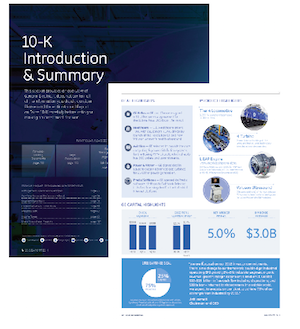How General Electric’s IR team applies its FastWorks style to spark new ideas in investor relations
When Matt Cribbins first became General Electric’s vice president of investor relations back in January last year, his father started pinging him several times a day with blog posts about GE that he’d seen on Seeking Alpha. Curious, Cribbins investigated further only to find that the company had 100,000 Seeking Alpha followers.
So he immediately began looking for ways ‘to become a part of the conversation.’ That’s how, he says, GE became one of the first companies to blog on Seeking Alpha.
Nor is Cribbins snobbish about where great ideas come from: he freely looks to other departments at GE, Silicon Valley and even his dad for inspiration. ‘The pace of business is only moving faster,’ he asserts. ‘Therefore, IR has to move with more speed, too.’
 Matt Cribbins, General Electric |
For example, Cribbins, a 20-year GE veteran who rose through the company’s vaunted leadership development programs, saw how successful GE’s corporate securities team had been two years ago in updating the company’s proxy, making it much more visually appealing and organizing data in ways that help investors find what they’re seeking.
His team borrowed what works best and transformed the quarterly earnings release into a ‘visual press release’ complete with an infographic style and a number of well-designed ‘highlights’ sections. ‘Sometimes I think, Let’s steal that idea,’ Cribbins says. ‘We’ll take best practices whether we find them, internally or externally.’
FastWorks’ approach in action
Innovating in investor relations isn’t a goal that’s easily brought to life, but Cribbins is finding ways to take GE’s latest management passion – FastWorks – and adapt it to investor relations. Noting that the company has moved beyond the Six Sigma and Lean processes, Cribbins describes FastWorks – which is at least partly the brainchild of Eric Ries, author of The lean startup – like this: ‘It’s all about learning, building, measuring and changing – and being quick to market with what we call a minimally viable product. Get it out there, learn, update, adapt, and launch the next generation of the product. It’s exciting.’
Cribbins says the same concepts apply in IR. ‘We listen to our investor base and get things out. We’re not afraid to try new things.’ Using a ‘mini-FastWorks idea’, he began inviting internal experts to join GE’s earnings call last year. Although he doesn’t feature a business leader on every call, he has invited Kieran Murphy to discuss GE’s $4 bn life sciences healthcare business, and Steve Bolze, CEO of the power and water division, who elaborated on the 2014 Alstom acquisition. ‘Getting our leaders out in front of investors is a big positive,’ says Cribbins, who keenly wants investors to appreciate the company’s deep bench.
While inviting visiting experts to the call has proven popular, Cribbins was not so concerned with the outcome. ‘If it doesn’t work, that’s okay,’ he says. ‘We’ll pivot and go in a different direction.’
Not all of the IR innovations Cribbins has tried are earth-shattering; some simply involve packaging existing information differently. When it came to the updated earnings release, for instance, Cribbins estimates that 95 percent of the information provided stayed exactly the same. ‘The format was easier to read, there were more charts versus numbers, more visuals,’ he explains. ‘We highlighted key topics important in the quarter, and it went over well with investors.’
Industrial revolution
As well as borrowing ideas from other departments, Cribbins has tapped GE’s award-winning digital communications team for help improving the IR site, which got 2 mn hits in 2014. ‘We asked the team to take a look at our website and tell us what it thought,’ recalls Cribbins. Suggestions included better navigation, more videos and links to what the company was posting on Facebook, LinkedIn and Twitter – all changes included in the December 2014 relaunch.
Cribbins also tries to communicate burgeoning FastWorks and other ideas percolating within the company to investors. One case in point is GE’s early adoption of the industrial internet. Over the past few years, the company has hired 1,200 software engineers in its San Ramon facility in Silicon Valley, all of whom are completely connected to GE’s engineers across its industrial businesses.
Through GE’s Predix platform, the company is driving productivity internally in terms of getting better data and information for its services businesses. In 2015 GE expects to earn $5 bn in software revenue, half of which is enabled by Predix.
Cribbins is actively exploring ways to bring GE’s discussions of the industrial internet to its investor base. Each fall, the firm holds an industrial internet meeting called Minds & Machines. In 2014, in addition to addressing 400-500 customers and suppliers, 125 investors joined the meeting. Afterwards, Cribbins organized an investor-only meeting to discuss what the industrial internet means to GE from a strategic perspective. ‘We think the industrial internet is going to continue to be an area we’re excited to talk to investors about,’ he says.
Reaching retail
 Bold design: GE has revamped the look and content of its IR newsletter, earnings release and 10k filing |
Many of the GE IR team’s innovations center on retail investors, who own around 41 percent of General Electric, or 4.1 bn shares. Another FastWorks-esque pilot currently underway is an effort to send ‘unique communications based on the audience, whether it’s to brokers or retail investors or institutions,’ says Cribbins. ‘We’re seeing whether there’s a difference in our hit rate.’
IR has begun disseminating topic-specific emails, too, such as one devoted to the process of exiting the majority of GE Capital. Cribbins also borrowed the button from CEO Jeffrey Immelt’s internal blog that says, ‘Let us know what you think’ to initiate a two-way dialogue. With these segmented email communications, Cribbins is building on the biweekly investor newsletter, which was revamped last year and now has 19,000 subscribers. Among the changes are more links so readers can click through to get greater detail on topics of interest.
He singles out last year’s overhaul of the 10K as particularly meaningful to retail investors: ‘If you’re not reading about GE everyday and you want a short snapshot of the company, the direction and the numbers, it gives you a lot of information.’
Before the redesign, Cribbins admits ‘there was a lot to grind through in the 10K.’ To make the reader’s job easier, the GE team ‘organized the disclosures by topic versus the traditional 10K line item format.’ And it created a new introduction section that not only discussed numbers, but also contained strategic insights to give context to the numbers.
Cribbins points out that the IR team ‘took some of the disclosures a step further’ by giving more information about sub-P&Ls within businesses. And the team has been thrilled with the results to date: the 10K had just 800 downloads in 2013, compared with 3,400 in the first half of 2015 after the new version was launched.
Finally, the IR team designed iPad and Google Play apps that have reached 3,000 downloads so far. Last year, there were 13,000 user sessions, and in the first six months through June of this year, there have been more than 20,000.
Although GE’s IR department doesn’t have its own dedicated Facebook, LinkedIn or Twitter presence, Cribbins makes sure to communicate his priorities to the digital communications team. He points out that the company has 350,000 Twitter follows so this communications channel matters.
‘We sit down [with the digital communications people] and have conversations about IR’s goals and objectives for the year. So if they see things that are helpful, they’re proactive about reaching out and saying, Hey, we’ve got this on Facebook. Let’s add a link here. Investors should see this,’ Cribbins explains. ‘Instead of recreating all the great work that’s going on across the company in digital media, we tap into it. In a world that’s moving quickly, we’re going to see more and more of this digitization trend in investor relations.’
IR in an M&A boom
Cribbins’ year-and-a-half tenure in IR has been marked by some historic organizational changes. In April 2014 GE announced its largest-ever acquisition with the purchase of Alstom, a French multinational with interests in electricity generation, followed by the IPO of Synchrony Financial in the summer of the same year. Next, GE began selling its appliances business and shrinking GE Capital. (GE Capital recently accounted for $365 bn in investment, but it is targeted to become only $90 bn in investment once sales are complete.)
With changes of this magnitude afoot, Cribbins knows ‘we have a lot to communicate on the IR front.’ When it came to Alstom, ‘one of the things we consciously tried to do was give more information than we’d ever given before.’ From an IR perspective, this meant flying to France in April 2014 in preparation for the announcement. ‘Given the size of the deal, we want to give targets and be more specific about the returns and the synergies,’ Cribbins says. ‘We want to give investors a chance to really understand the strategy and the economics of the deal. I would say a good 60 percent to 70 percent of all the questions I got from April to June last year were about the acquisition.’
Alstom was critical because it marked a strategic shift for GE. ‘It was pushing the company more toward being an industrial company,’ explains Cribbins. ‘And people saw that our earnings as a percentage of our industrial business versus our capital business would be increased.’
He also points out that the Alstom acquisition attracted more international shareholders. GE’s international shareholder base has roughly doubled since 2005 and is now at approximately 21.2 percent. Although GE’s IR team is lean and has become smaller over the years, there’s a dedicated individual – Gerrit Schneider – in Germany whose job is exclusively communicating with the company’s non-US shareholders.
Having worked in more than 25 countries and spent four years in Tokyo, Cribbins values a global mind-set. ‘Most of GE’s revenue comes from outside this country,’ he says. ‘In today’s world, you cannot be US-centric and be successful in business.
Looking to the future
For Cribbins, IR boils down to three principal objectives: supporting management and the team by helping communicate the strategy and the results of the company, broadening the ownership of the company, and serving as ‘the voice of the investor inside the company.’
Success hinges on a nimble attitude and a FastWorks approach to innovation. Cribbins also emphasizes an ongoing effort to measure success with a dashboard that feeds him metrics on everything from stock performance and the number of IR meetings conducted – with and without management – to the number of newsletter subscribers on any given day. ‘I came up through GE’s leadership programs, and what I learned early is that what you measure gets done,’ he says.
Focusing on the metrics necessary for success matters because the company – and the world – are in a constant state of flux. ‘No matter what, investor relations is never the same,’ observes Cribbins. ‘That makes it a lot of fun.’
Even though GE is an iconic company that has been around for 120 years, Cribbins concludes by emphasizing the need to experiment: ‘You always have to innovate so that’s what we’re doing as a company – and that’s what we’re trying to do as an investor relations team.’
This article appeared in the Fall 2015 issue of IR Magazine










